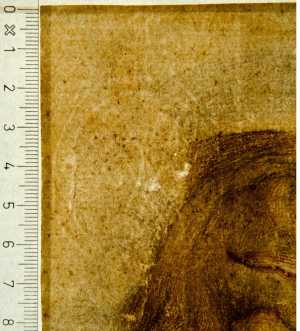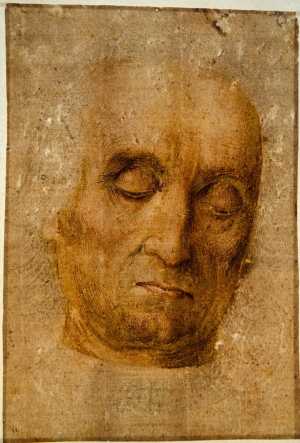Specifications
| Title | Portrait of a Man Looking Down |
|---|---|
| Material and technique | Black chalk and bodycolour |
| Object type |
Drawing
> Two-dimensional object
> Art object
|
| Location | This object is in storage |
| Dimensions |
Height 194 mm Width 133 mm |
|---|---|
| Artists |
Workshop of:
Domenico Ghirlandaio
Previously attributed: Ridolfo Ghirlandaio |
| Accession number | I 469 (PK) |
| Credits | Loan Stichting Museum Boijmans Van Beuningen (former Koenigs collection), 1940 |
| Department | Drawings & Prints |
| Acquisition date | 1940 |
| Creation date | in circa 1485-1500 |
| Signature | not signed or dated |
| Watermark | Crossed keys in double upright circle with Latin cross (contour) above (70 x 43 mm, upside down, below right, on P4 of 4P, vH), similar to Briquet 3899 (Venice 1498). [see image] On the backing sheet: none (vH, 3P). |
| Inscriptions | 'WYO.' (l.o., pen in bruine inkt), 'Pintoricchio / (Bernardo di Bragio) / 1454- 1513 / Silverpoint chalk & colours.' (on removed backing sheet, below left, pencil) |
| Collector | Collector / Franz Koenigs |
| Mark | William Young Ottley (L.2665), F.W. Koenigs (L.1023a) on removed backing paper |
| Provenance | William Young Ottley (1771-1836, L.2642, L.2662, L.2663, L.2664, L.2665)***, London; - ; Dr. Ludwig Pollak (1868- ? 1943, L.788b), Rome; - ; Dr. Benno Geiger (1882-1965), Vienna/Venice, his sale, London (Sotheby) 07-10.12.1920, lot 230, ill. (Pintoricchio, BP 33 to Sabin); - ; Art dealer Julius W. Böhler (1883-1966), Lucerne; Franz W. Koenigs (1881-1941, L.1023a), Haarlem, acquired in 1929 (Pietro Perugino, corrected in Ridolfo Ghirlandaio); D.G. van Beuningen (1877-1955), Rotterdam, acquired with the Koenigs Collection in 1940 and donated to Stichting Museum Boijmans Van Beuningen |
| Exhibitions | Amsterdam 1934, no. 553; Paris 1935, no. 552; Rotterdam 1938-1939, no. 47; Paris 1952, no. 9; Rotterdam 1952, no. 93; Rotterdam 2007 (PvdEerden); Rotterdam (Rondom Fra B.) 2016 |
| Internal exhibitions |
Tekeningen uit eigen bezit, 1400-1800 (1952) Rondom Fra Bartolommeo (2016) |
| Research |
Show research Italian Drawings 1400-1600 |
| Literature | Planiscig/Voss 1920, no. 1, ill.; Amsterdam 1934, no. 553 (Ridolfo Ghirlandaio, before Pintoricchio); Paris 1935, no. 552; Berenson 1938, no. 899A, fig. 362 (Ridolfo Ghirlandaio); Rotterdam 1938-1939 (Ridolfo Ghirlandaio), no. 47; Hannema 1942, ill.; Geiger 1948, pp. 9, 17, no. 1, ill.; Haverkamp Begemann 1952, no. 93 (Ridolfo Ghirlandaio); Griswold 1989, p. 215 and p. 220, no. 1 |
| Material | |
| Object | |
| Geographical origin | Italy > Southern Europe > Europe |
Do you have corrections or additional information about this work? Please, send us a message

























